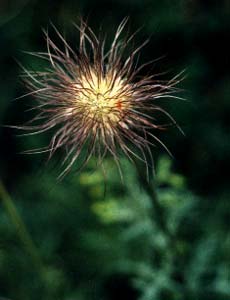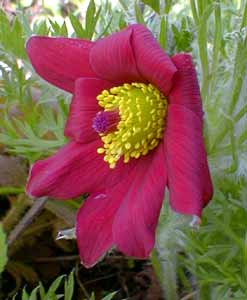
'Red Clock' Pulsatilla or Flawflower;
aka Pasque Flower or Pasqueflower;
aka Wind Flower or Easter Flower;
aka Passe or Paschal Flower;
aka Meadow Anemone
"For thee to bloom, I'll skip the tomb
And sow my blossoms o'er!
Pray gather me, Anemone,
Thy flower forevermore!"
-Emily Dickinson
(1830-1886)
(1830-1886)
'Red Clock' is the cultivar name of this particular Pulsatilla vulgaris (formerly Anemone pulsatilla). It is a clumping perennial that grows to a foot or a foot & a half tall, & one foot round.
'Red Clock's' yellow-hearted crimson flowers appear in early spring (March through May; shown in a late March 2004 photo at the right), beginning to bloom immediately before it produces new pubescent leaves. The wild purple-flowered variety blooms later, April through June.
 They are called Pasqueflowers, Paschal Flower, or Easter Flowers, because they are still in full bloom around the time of Passover. The leaves have occasionally been added to soups for Passover feasts, despite mild toxicity.
They are called Pasqueflowers, Paschal Flower, or Easter Flowers, because they are still in full bloom around the time of Passover. The leaves have occasionally been added to soups for Passover feasts, despite mild toxicity.While spring leaves develop below the first flowers, the flowers continue to be produced, while the earliest flowers in the clump begin to turn to gorgeous fluffy-spiky seedheads resembling the seeds of clematis.
One of these silvery-soft seedheads is shown in the August 2003 fruit portrait upper left on this page. The beauty of the spring flowers followed by the beauty of summer fruits adds up to a very long-lasting ornamental strength.
The "Clock" of the cultivar name alludes to these fuzzy seedheads, a clock being a name for dandylion seedheads, also called a "Blow" because the seedheads take to the wind when blown. Why "Clock" I'm uncertain, but by a children's belief it is possible to tell what time it is by blowing on dandylion seeds. If it takes three puffs to blow all the seeds free, that means it is "three blows" or "three of the clock." Obviously this time-telling method is completely without rational merit, & I don't know whether the game arose from the common name, or the common name from an old folk belief that survives as a children's game. But my guess is that the names "blows" & "clocks" became interchangeable for such seedheads because the terms were already interchangeable for timepieces that announced time by the number of hourly blows of a hammer.
When fully ripened the pulsatilla seeds are scattered by the wind, hence another common name, Wind Flower, for anemones & pulsatillas alike. The scientific name Pulsatilla also alludes to these gorgeous seeds, from the latin pulsare meaning to beat or sway, as in the wind. So too Pliny called it herba venti, "plant of the wind."
Most of its common names are easy to understand as to inspiration. "Crowfoot" for instance notes the shape of the leaf. But why it has been known as Smell Fox (or Smellfox) is most curious since the flower has no particular scent, whereas foxes smell rather rank. The name seems to have migrated from that of P. nigriscens which has the scent of a dog's wet coat.
Pulsatillas & anemones share many of the same common names; Anemone nemorosa for instance is likewise sometimes called Smell Fox, & reportedly has a bad odor, though I cannot smell anything nasty from our wood anemones, which seem scentless. Indeed, another ancient name for anemones is "the scentless rose," a name of the flower that sprang from the blood of slain Adonis the lover of Aphrodite, identified with the anemones & pulsaillas.
Pulsatilla is native of Great Britain, France, Switzerland & the Ukraine. It requires lots of sun & well-draining soil. As an alpine flower, it needs protection from overheating. It prefers limy alkaline soils but does well enough in our Northwest loamy acidic soils. I insert a stick of blackboard chalk in the woody root system each spring as an alkalinizing feed that won't spill over to the majority of plants that dislike alkalinity. Once established, it resents being transplanted, so its position should be carefully selected.
Although this member of the buttercup family should be regarded as dangerously toxic, it is nevertheless often used medicinally, from ancient times to modern folk remedies. Pliny regarded it as a pain killer; Dioscurides used it to treat infected soars. It has been alleged useful in curing lameness caused by vericose veins or venereal disease, besides many other complaints. Elizabethans dried & powdered the flowers to use as snuff for headaches. It has become rare in the wild because of herb harvesting. Although the medicinal possibilities of its alkaloids are real enough, so too is the likelihood of being harmed by ingesting even small amounts of this potent herb.
It has acquired some small bits of mythology, as is true of many useful plants. It was believed that the flowers closing early in the day fortold stormy weather; or they were said to close their petals at night because fairies slept within. Pulsatilla collected for bouquets were believed to protect the household.